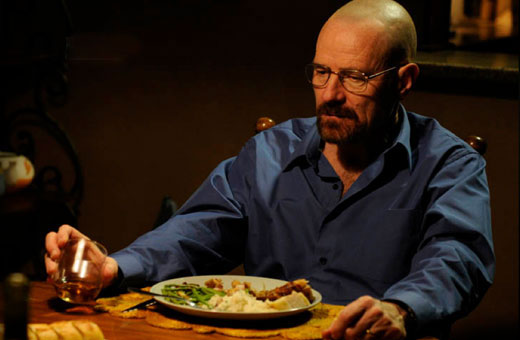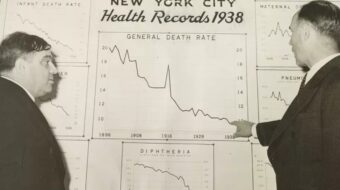
Sunday’s premiere of Breaking Bad season six dispelled any worries that its creator Vince Gilligan would start the last season with a slow burn toward an explosive finish. The first episode, “Blood Money,” seems to promise that the central character, Walter White, will hurtle toward his fate at dangerous speeds.
Breaking Bad belongs to a pantheon of great television that has explored dark and gritty themes for more than a decade. Brett Martin’s excellent new book Difficult Men: Behind the Scenes of a Creative Revolution argues that a small group of creators, themselves difficult men in certain respects, have shaped this “third golden age of television.” The first such golden age, Martin claims, took place in the late ’40s and early ’50s before censorship closed off early TV’s creative possibilities. The second came with the early 80s, the Hill Street Blues era and the birth of the TV drama.
Martin suggests that these are mere flashes in the pan in comparison to TV’s true aegis of greatness, the present. This revolution in storytelling began with David Chase’s Sopranos, arguably reached an early apotheosis in The Wire and has come to full fruition in brilliant shows like Mad Men, Dexter, and, of course, Breaking Bad.
Martin’s book, Difficult Men, has rightly received lots of attention. This is not surprising, as it’s not only stylistically entrancing but also contains a very interesting template for making sense of why American TV suddenly got so good. Interest in the book, of course, also has something to do with the fact that it dropped right around the time of the death of the actor who portrayed that primal difficult man, Tony Soprano.
Although it makes a compelling argument, Difficult Men contains plenty of holes. Jenji Kohan’s Weeds barely gets a nod even with its female anti-hero Nancy Botwin, portrayed by Mary Louse Parker with all the narcissism and self-destruction Jon Hamm (Mad Men), James Gandolfini (Sopranos), and Bryan Cranston (Breaking Bad) packed into their characters. Moreover, ensemble genre TV from the last decade gets zero attention. Joss Whedon’s Buffy the Vampire Slayer and Firefly, as well as Ronald Moore’s reboot of Battlestar Galactica, employed story arcs, complex characters and a penchant for dark themes that comports exactly with the model Martin presents. But he doesn’t bother with them.
Breaking Bad has also made a centerpiece out of the realities of class and economic vulnerability, another idea mostly ignored by Martin (except in his detailed description of the backstory behind The Wire). The central character, Walter White, originally a high school teacher who has to moonlight at a car wash in order to maintain his family’s modest lifestyle, first “breaks bad” in order to pay the gargantuan medical bills that accompany his diagnosis with cancer.
Downtrodden Walt transforms over six seasons into a self-described empire builder. In this fashion, showrunner Vince Gilligan picks up a theme common to most “difficult men” stories on TV: the moral ambiguity of criminal activity in the culture of Wall Street malignancy. In other words, as Martin puts it, “the notion that the American dream, at its core, might be a criminal enterprise.”
The Sopranos introduced this theme by frequently raising questions about who “the real gangsters” were in the boom economy of the ’90s and early 2000s. The sub-prime mortgage meltdown made dealing drugs to hang onto your previously underpriced square footage seem sympathetic in Weeds. Don Draper’s ability to harness his creative genius to the task of selling a false dream of abundance seems vintage in comparison to today’s complete commodification of every human experience. Even Walter White’s empire-building appears positively humane when set against Halliburton’s behavior over the last decade – a corporation that has many of the characteristics of a rogue state.
Breaking Bad also comports with the television Golden Age’s tendency to create what we could call narratives of middle class subversion. In them, the promise of the American dream, often defined by McMansion, collides with a deep and abiding sense of both economic insecurity and inward malaise. They are stories of going bad in the suburbs, both because the consumerist elysium proves impossible to maintain and ts promises of fulfillment prove ultimately empty.
Walt, after all, has more problems than cancer. He evokes our sympathies in the first episode during an utterly humiliating scene in which he has to wash the car of one of his problem students, a car he could in no way afford on his public school teacher’s salary.
Crime, as Walter makes clear to his sidekick Jesse in season five, offers something much greater than money. Walter’s transformation into his criminal kingpin persona Heisenberg offers power over the seemingly impersonal forces that have buffeted him from every side, from the economic dead-end of his profession to his unpayable health care costs.
Historian Eric Hobsbawm coined the term “social banditry” to describe criminal figures who become representatives of social vengeance. Jesse James is the primary American example, a bad man whose war on the railroads in Robber Baron America cast his misdeeds as a struggle for social justice.
Walter White and his fellow TV outlaws are our social bandits. Their struggles have taken place amidst some of the most wide-ranging crimes of postindustrial capitalism. Their prominence in the collective dream life of our TV screens embodies at least vestigial revolutionary hopes in a society where corporate gangsters, as Tony Soprano might say, have us by the balls.
Photo: Breaking Bad official AMC site












Comments